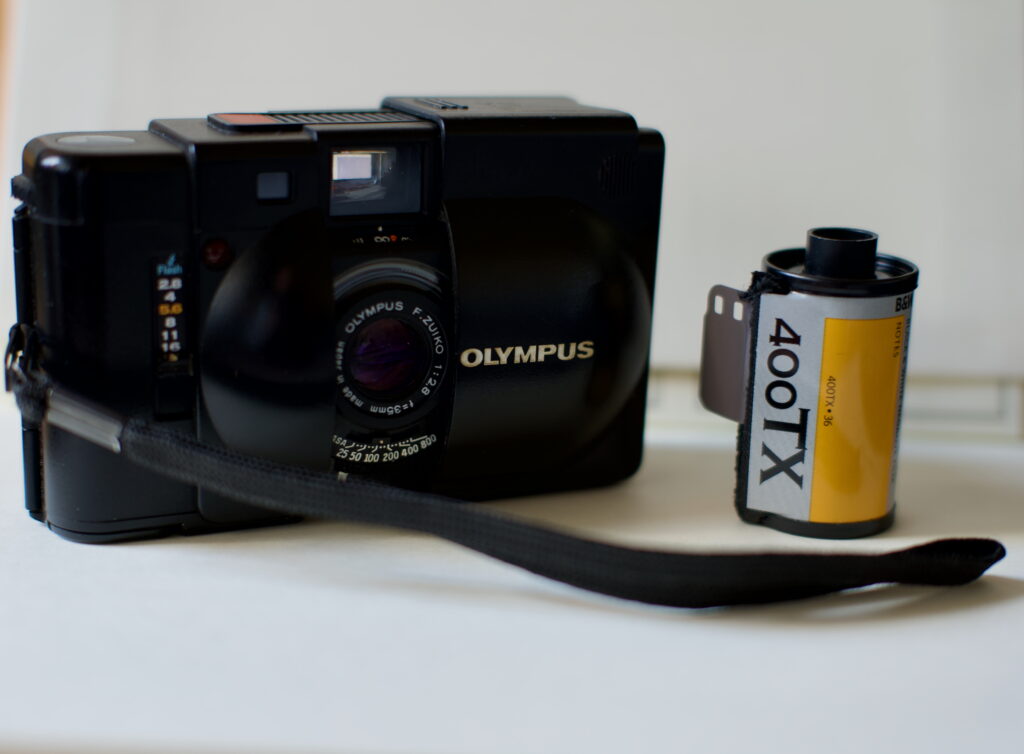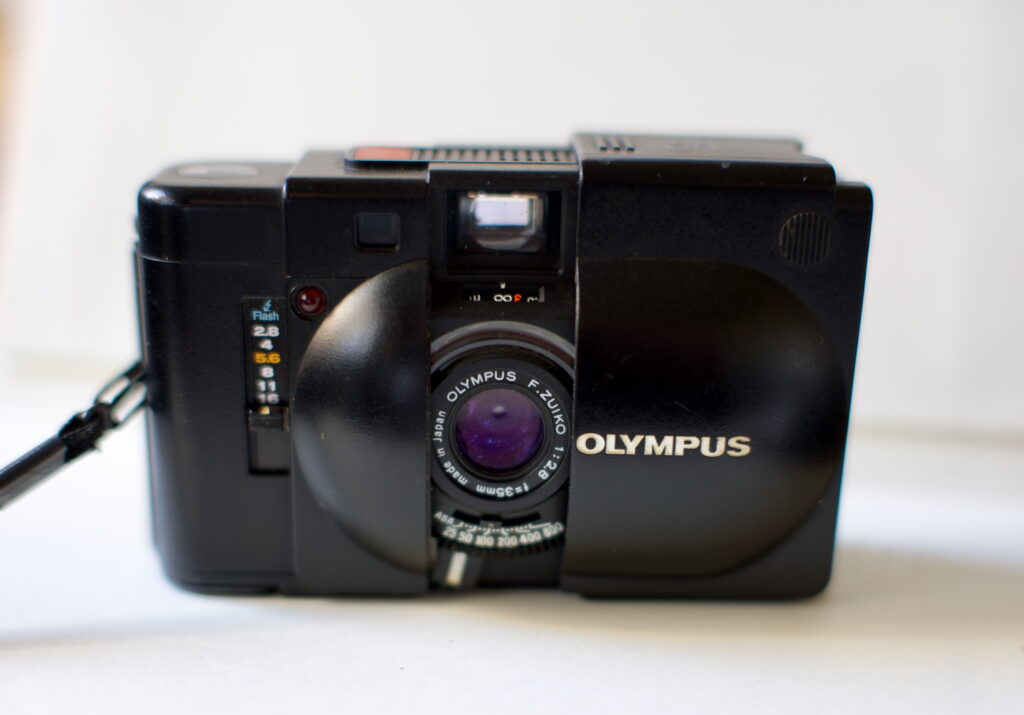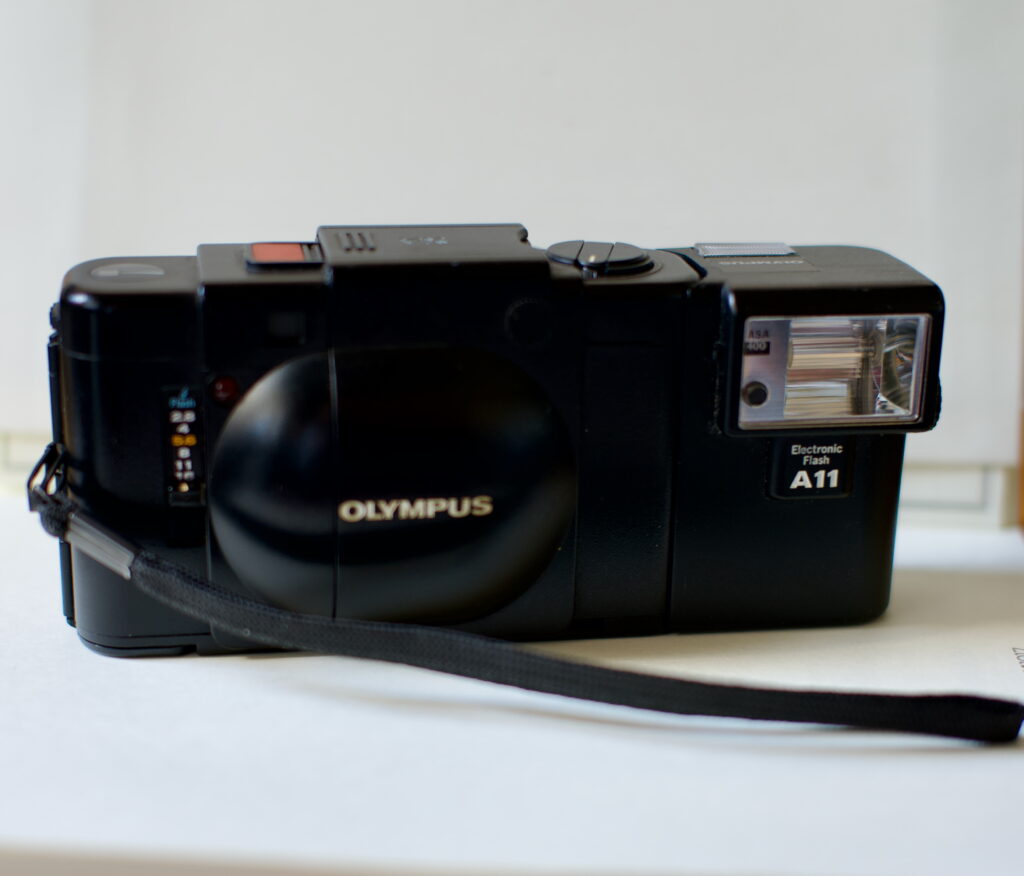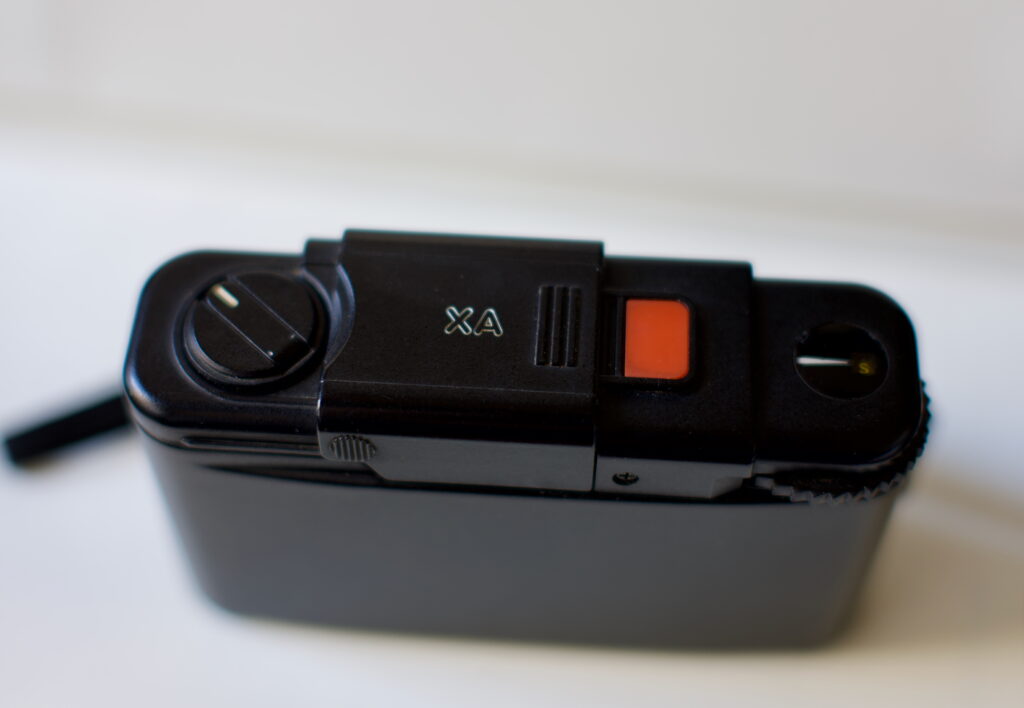Mentioned in a post back in January, an old friend has returned in the shape of an Olympus XA. This would be the third one I’ve had (or forth including a duff one that was beyond redemption!), along with an XA4 I had for for a while, which has a 28mm lens as opposed to a 35mm others in the series use. The XA4 also does macro photography, even coming with a wrist strap that doubles as a measuring device to help you work out the minimum focus distance. Clever folks the Japanese!
Why do I like the XA? Before virtually everyone carried a phone able to take photos , the XA series was one of the smallest 35mm compact camera and certainly the easiest one to slip into a pocket, providing you didn’t have the flash unit attached. The ingenious sliding cover also meant you didn’t need (and better still couldn’t lose!) a lens cap, whilst at the same time, prevented random shots of a dark pocket by locking the shutter release.
But as ever with Olympus, the best bit was the lens, the 35mm f2.8 used was really good, and 35mm is generally regarded as the ideal focal length for street photography. Combine this with a very discrete camera and you’ve the ideal tool for unobtrusively strolling around a town and taking photos.
Where the XA, the original model released and for many the best one, differs from those that followed in the series, is it uses aperture priority and is a rangefinder, having a small lever under the lens mount which controls what’s called a “coincidence image” displayed in the viewfinder. Align the coincidence image with the actual scene and you’ve got the focus correct, though this only works for images of subjects up to 3m from the camera. With a small aperture control slider handily placed for your right index finger to adjust, giving you more control of your exposure, depth of field, and hence your images. All the other models used a simpler three position zone focussing lever, with icons showing a person’s head, two people side by side and some mountains, denoting close up, far enough away to get two people in the frame and focussed, or landscape beyond that ; except the XA1 which we’ll come to later.

The only other functions available are accessed from a small flip switch built into the camera base, which aside from proving in a battery check function, enables the self timer and on all bar the XA1 and XA2, provides +1.5EV exposure compensation for backlit shots. Metering relies on a pair of LR44 cells and oddly, these actually power a pair of light sensors within the camera, one controls the actual exposure, whilst the other the swinging needle in the viewfinder to indicate your exposure. This sadly means that an XA can appear to be working fine through the viewfinder, but won’t fire the shutter as the film exposure meter is faulty. Given the XA first arrived in 1979, it should come as no surprise that the electronics on many have failed over time and there’s no spares.

Film sensitivity is set by another tiny slider built under the lens housing and goes from 25 to 800 ISO on the XA and XA2, while the later XA3 and XA4 go to 1600 ISO, the later pair also includes electrical contacts in the film housing to read DX speed off a suitably encoded 35mm film can, setting the correct ISO automatically.
The oft derided black sheep of the XA series arrived in 1982, around the same time as the XA2, in the shape of the “budget” XA1. This was to all intents a repackaged Trip 35, shoehorned into a modified XA series shell. The metering is handled by the same CDS type cell arranged around the lens that’s found on the classic Trip, so no need for batteries. Only ISO 100 and 400 film speeds are available, while the lens was a fixed focus 35mm f4. The other give away to being derived from the Trip is the shutter button. The rest of the XA series have a flat red button, just a plastic panel flush with a ridge atop the middle of the camera shell that the shutter cover slides across, while the XA1 has an identical black plastic rod type button to those found on the later Trips, coming out of a hole more towards the front of the top of the camera case.

Along with the cameras, Olympus did a series of four matching flash units that attached to the left hand side of the camera body with a small thumbscrew. What was essentially the standard unit was the A11, powered by a single AA battery, OK for a bit of fairly close fill in or a head and shoulder portrait, though had rather glacial recharge times. The A16 was a slightly bigger and more powerful unit that needed two AA batteries, and both these units were automatic, adjusting output and duration according to a light sensor which resides beside the flash head and below the window that indicated which film speed, 100 or 400 ISO, you’d set. The A9M was supplied with the much simpler XA1, and was all manual, so a very basic flash unit. Olympus also had a thing about “disposable” around this time and the A1L flash had what was supposed to be a “use until expired” Lithium battery built in, much the same as the AF-L Quickflash camera. Fortunately, if you’re handy with screwdriver and soldering iron, you can replace the batteries in both. The A1L itself was a low powered unit designed for the XA4 and suitable for macro photography.

One of the most divisive features on the XAs that had one, is the red flat plastic shutter release button. Other than being prone to splitting when they got old, or falling off in general, there’s not a deal of tactile feedback to them. They don’t depress far anyway, a bit like a Sinclair ZX81 keyboard in many ways, as that kept out dust and the odd water droplet, so functional if nothing else.

In mint condition, the XA now commands what seems like silly money compared to the £50 I paid for my first one in about 1983 (even after inflation!), especially if comes with the original plastic presentation box. The XA2 and XA3 are generally cheaper, though many people prefer these for street photography as they can simply set them to the desired zone and shoot, no need to focus. The XA1 is undoubtedly the unloved cousin in terms of value and the CDS meter on these suffers the same issue as all CDS meters if you leave them exposed to light, they stop working! So keep the slider closed or the lens cap on. Star of the XA series cost wise is the XA4, primarily due to low production volumes and being the only one with a 28mm lens. There were also a few XA2s produced with coloured shells, white, blue and red, (possibly grey as well) again these command more than the standard version due to their rarity.
With production ending in 1991, succeeded by the Mju series of auto focus compacts, which have also gained a cult following (AKA cost stupid money for a plastic compact camera ) in recent years, you have to be careful if you’re thinking of buying one. As mentioned the electronics can be a bit fickle, the plastics can age making them brittle and then there’s the usual issue with fungus in the lens or viewfinder, along with general mechanics issues with hardened grease in gears etc. Aside from leaving batteries in them and the corrosion these can cause when left untouched, or the light seal foam going sticky and disintegrating, it’s the electronics that seem to degrade the worst. Repairable, yes to a point, worth it, not unless you can do it yourself and you can find the relevant diagrams online.
But find a well loved worker, put a roll of your favourite 35mm poison through it and learn to love a classic.


